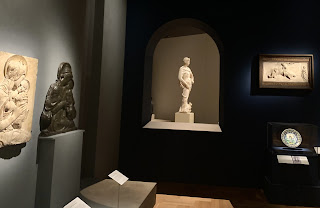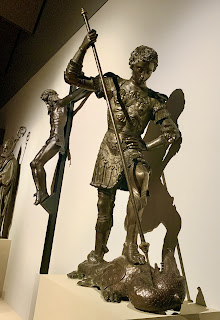Ask the proverbial "people on the street" to name a sculptor from the Italian Renaissance, and even the ones without a trace of interest in art history stand a good chance of coming up with the name Michelangelo. He and his David are so big, they've crossed into pop culture. Go back a century and a half, however, and the answer would have been different. Donatello would have dominated the consciousness back then, just as he had in the four hundred years since his death.
It's not hard to see why Michelangelo connected with the 20th century: rebel, sculptor of muscle-bound figures of power, portrayer of brutal force and raw emotion, immortalised as a restless, troubled genius in modern book and film. But if you want to really touch the spirit of the Renaissance, from its obsession with classical elegance to its love affair with beauty and humanism to the very warmth of its sun-baked piazzas, Donatello is your man.
The Victoria and Albert Museum's new exhibition,
Donatello: Sculpting the Renaissance, sets out to prove that point, and does so with style.
Curators divide their cavernous main space into three sections with arches, walls and loggias, so you find yourself in an abstract distillation of a Tuscan townscape. The first part explores the young Donatello and the workshop system that trained him. There’s work from plenty of names you probably don’t know here, all beautiful, showing the collaborative spirit of the age and the way all the artists influenced each other. We learn about, and see an excellent video on, the jewellery making that was … like many other Renaissance craftsmen… Donatello’s first trade. Many feel that starting at such a fine, intricate scale is what gave the sculptor his virtuosity when he moved to larger scale works, particularly his bronzes.
The heart of the show is pure Donatello, with free-standing figures, portrait busts, tombs and relief sculptures contributed from museums across Europe. Florence’s Bargello has been particularly generous, but this show started with them and came through Berlin before its triumphal conclusion in London.
The exhibition closes with a look at Donatello’s outsized impact on the art world, particularly in the century after his death and in the huge Renaissance revival of the 19th century. It’s amusing to see the counterfeits in this section created to sate a voracious hunger for the artist. And there are works from as late as the 1920s that exactly copy his style.
While Donatello worked across central Italy, he was indelibly a son of Florence. Any visitor to the cradle of the Renaissance will have seen so much of his work on plinths, walls and in niches, standing amidst so many other wonders of the age, that it’s possible to take it all for granted. The real glory of this show is the way it takes works out of their sensory-flooding contexts and stands them alone, allowing you to fully appreciate just how remarkable they are.
I don’t think anyone in art has been as good at capturing the contradictions of boys on the brink of manhood. Here we’re treated to two Davids, a Saint George and a John the Baptist, all shown as teenagers at that exquisite stage just before their elegant, androgynous features are rewritten by manhood. They exude that curious mix of confidence and doubt, power and fear, one foot in reality and one in some dreamy nether world so distinctive of the age group. The details on St. George’s armour are particularly impressive, reminding us of Donatello the jeweller. So beautiful is the young man in his martial glory we can forgive the fact that the dragon looks as menacing as a golden retriever.
But Donatello isn’t a one trick pony. His women are just as beautiful as his men, shown off by a whole wall of Madonnas and their children. The mothers are ethereal, soft and warm despite the stone they’re made of. The children are plump and adorable. You want to reach out and wiggle a toe or squeeze a fat little thigh. His mastery of children is at its height, however, in a series of spiritelli. (This was a new term for me. Why these frolicking winged children aren’t cherubs or putti is a nuance I can’t explain.) It’s as if someone covered fat, gorgeous babies at peak giggle with a thin coat of bronze to preserve them forever.
He doesn’t just do feel-good art. There are wizened, life-beaten men in a series of portrait busts, a classical form Donatello helped revive. The bronze Christ on loan from the cathedral of Padua is heart-rending in its emaciated pain. An over-sized head of a classical god is as frightening as he is attractive. And yet these, too, are all wondrously beautiful.
Your jaw is most likely to drop, however, when you look hard at Donatello’s relief sculptures. A relief is a sculpture that rises out of a flat background rather than standing on its own; think of the raised images on a coin. Donatello is credited with inventing a technique called rilievo schiacciato, a kind of squashed relief … the whole thing only a few millimetres deep … where the artist manages to show many layers of depth.
The best example of this is a panel depicting the ascension of Christ, carved from snowy Carrara marble. The exhibition is using this as its lead image in marketing but photography can’t convey its wonder. Christ, Mary and the apostles occupy three different planes. Angels and putti are on at least two more in the background. And then the landscape recedes, in wave after wave of hills, with tiny but perfect town walls barely scratched into the marble. All created from a piece of stone no thicket than your thumb. Elsewhere the receding background is layer upon layer of architecture, while in front a crowd watches St. Francis offer communion to a donkey. (One of his more delightful legends.) That one is in bronze, as is a Crucifixion where crowds, architecture, angels and distinctive Italian umbrella pines draw your eyes ever deeper into the complex scene.

This last relief hangs in the section on Donatello’s legacy, beside copies by followers that are beautiful, but can’t quite compare to the master’s combination of technical perfection and mastery of beauty. That didn’t stop them from following in his footsteps. Much of the look and spirit that defines the Renaissance emerged beneath Donatello’s chisels over more than 60 years of productive work. Everyone that came after studied him, including a young man who would have copied Donatello’s works in the Medici gardens when he started his own training some twenty years after the master’s death. His first work would be a rilievo schiacciato of madonna and child with winged putti occupying various planes of a receding background. Very Donatello. Except the figures are more muscular. More masculine, even though they’re children and a young mother. Michelangelo had arrived. But he wouldn’t have gained his current fame had he not stood on the shoulders of the earlier master.
Donatello: Sculpting the Renaissance is on at the Victoria & Albert Museum until 11 June. Reviews have been universally ecstatic, so weekends are likely to sell out.




No comments:
Post a Comment